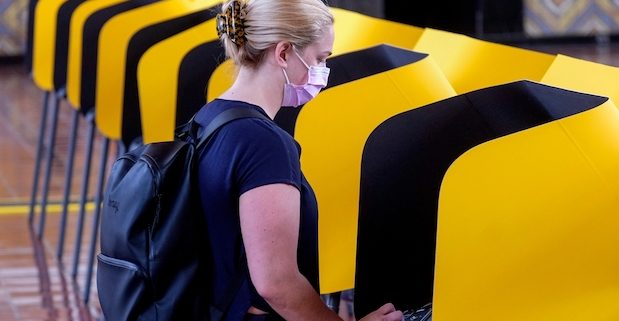News
Reforming California’s recall system gets close look
 A woman casts an early ballot in the recall election at L.A.'s Union Station. (Photo: Ringo Chiu, via Shutterstock)
A woman casts an early ballot in the recall election at L.A.'s Union Station. (Photo: Ringo Chiu, via Shutterstock)The word “recall” dominated California politics this year, but it’s not over: The recall may go before voters again, this time in the form of a reform measure placed on the statewide ballot by lawmakers.
On Tuesday, voters overwhelmingly opposed removing Gov. Gavin Newsom from office by about 64 percent to 28 percent, or about 5.8 million to 3.3 million ballots cast, according to an early count. The election was called by an array of news outlets less than an hour after the polls closed at 8 p.m.
The proposed reform stems from complaints — mostly, but not entirely, from Democrats — that California’s recall process is deeply flawed, allowing a replacement candidate with scant voter support to become governor.
Newsom, a Democrat, faces reelection in November 2022. It was uncertain if any recall reform measure would appear on that ballot or on the June 2022 primary election ballot.
Assembly Speaker Anthony Rendon is considering a reform measure for the 2022 ballot. One option, sources said, would change the current two-step system to a single-question proposition, asking whether voters favor removing a governor from office.
“It is totally appropriate to begin discussion of reforming the recall process. We came far too close to having a governor elected by a tiny fraction of eligible voters,” Rendon, D-Los Angeles, said in a a written statement.
Senate Leader Toni Atkins, a San Diego Democrat, agreed. “A thorough review of California’s recall law is timely and worthy of debate.”
Their comments were contained in a statement distributed by the offices of state Sen. Steve Glazer, the chair of the Senate elections committee, and Assemblyman Marc Berman, chair of the Assembly elections committee.
The committees plan hearings on recall reform proposals. Both legislative houses are overwhelmingly controlled by Democrats.
Newsom, a Democrat, faces reelection in November 2022. It was uncertain if any recall reform measure would appear on that ballot or on the June 2022 primary election ballot. Traditionally, California’s statewide general elections have a greater voter turnout than primaries and since Democrats have dramatic edge in voter registration, a November 2022 target is likely.
Under one option, if a simple majority say yes, the governor would be removed and the lieutenant governor would automatically become governor. Other options include raising the threshold for replacement candidates to appear on the ballot.
Currently, California voters are asked whether to remove the governor and, if a simple majority say yes, they are then asked to pick a successor from among a list of candidates. Whoever wins the most most votes from those contenders — there were 46 candidates in the Newsom recall — would then become governor.
Changing the existing system, which has been in effect since 1911, would entail a constitutional amendment requiring voter approval. There have been 55 recall attempts against governors over the years, and 179 attempts against statewide officials. Newsom has been targeted in six recall efforts.
Thus far, voter turnout is about 41.6 percent, the secretary of state said. Updated numbers on the count and turnout are expected later this week.
Want to see more stories like this? Sign up for The Roundup, the free daily newsletter about California politics from the editors of Capitol Weekly. Stay up to date on the news you need to know.
Sign up below, then look for a confirmation email in your inbox.

Leave a Reply